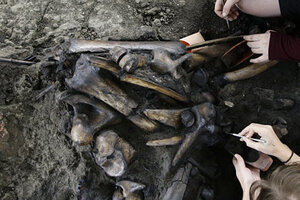La Brea Tar Pits: What has emerged from L.A.'s prehistoric asphalt?
La Brea Tar Pits: A century ago this week, scientists began excavating bones from the La Brea Tar pits. Here are three discoveries that have emerged from the gooey trove of paleontological treasures.

Excavators use dental picks to clean 42,000-year-old bison fossils at the La Brea Tar Pits on Wednesday in Los Angeles. On Monday, the George C. Page Museum celebrated a century of excavation at the La Brea Tar Pits, considered the richest and most diverse collection of Ice Age fossils.
Jae C. Hong/AP
During the period when modern humans had finally trudged onto to every continent but Antarctica, glaciers were inching across a cooling earth, and all other human species went extinct, millions of animals had the misfortune of getting stuck in a thick, hot, belching pool of tar at one edge of North America, and died.
Shaggy mastodons succumbed, trumpeting, along with hissing saber-toothed cats, fluttering insects and birds, panicked rabbits. That pool continues to belch, 11,700 years later, and the ancient asphalt packed around its edges contain one of the world's richest collections of once-living tidbits from the Late Pleistocene period.
A hundred years ago this week, paleontologists began to excavate those fossils, and scientists at the George C. Page Museum have still catalogued only a small fraction of its specimens. Here are a few exciting discoveries drawn out of Los Angeles' Rancho La Brea site, known to most as the La Brea Tar Pits.
Saber-toothed softy
Feline tissues exquisitely preserved in Rancho La Brea tar have taught us that the saber-toothed cat, Smilodon, who we once imagined to be a scrappy, solitary scavenger, in fact likely stalked prey along the ground, using powerful hind legs to launch its immense fangs toward vulnerable bellies. And, we have learned, that same kitty purred, roared, and probably practiced social cooperation.
Clogged bones
The burbling tar in Rancho La Brea, which churns together remains from various epochs rather than letting them settle in layers, poses unique problems for dating remains and reconstructing the various ecosystems which once included them.
For one, the tar is so old that it contains no measurable amounts of radiocarbon, the material normally used for carbon dating. So when bones are excavated, completely permeated with tar, the lack of carbon-14 in the tar skews measurements of how much is left in the bones themselves – and makes it hard to know when a given animal died and began to decay.
Scientists have been working for awhile, on good ways to remove the tar from those bones. They've crushed, dissolved, and gelatinized them, before breaking down their collagen into individual amino acids, which can then be carbon dated.
But that is an incredibly labor-intensive process, which slows the Page Museum's cataloguing process to a prehistoric snail's pace. To make this process easier, a research team from the University of California Irvine found that they could use a whirring centrifuge to separate the bone-tar slurry's components by molecular weight. Three distinct materials emerged: black tar, brown asphaltene-clogged bone, and – triumph – clean bone-colored bone, perfect for carbon-dating. This technique can now be used to study remains dredged out of the handful of other asphalt pools around the world.
Who's eating whom
The same research team has also found a way to understand who was eating what around the tar pond, at various points in pre-history. Using a technique called stable isotope analysis, they've begun to look at what kinds of carbon and nitrogen are present in plant and animal tissues, to learn what those life-forms were consuming, and what the food web connecting them might have looked like. Some plants, for example, create carbon-12, and others create carbon-13, so we can measure proportions of these isotopes in herbivores' tissue to reconstruct their diet.
Using this technique, another research team discovered that the California condor, a lanky bird that curiously outlived most of its prehistoric bird contemporaries into the present day, seems to have survived at least partly on scavenged sea life during the last Ice Age, based on specimens found in the tar pits. While California's ecosystem took a big hit, extinguishing many other species, the condors may have hung on because the marine component of their diets remained available.
"What makes La Brea so unique, is that you have basically the whole ecosystem preserved there," says John Southon, one of the scientists involved with this research. "It wasn't just big animals falling into the tar. You've got leaves, and twigs, and bugs, and mice, and groundsquirrels, all the way up to mammoths and mastodons and saber-toothed cats."
"The more we know about how ecosystems work, the more intelligently we can plan for the future," he added.

